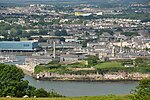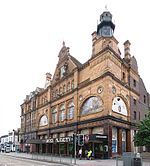Brigade Patrol Troop
Airborne units and formations of the United KingdomMilitary units and formations established in the 1990sRoyal Marine formations and units
The Brigade Patrol Troop is a reconnaissance troop of the United Kingdom's Royal Marines and is part of the Surveillance and Reconnaissance Squadron (SRS) within 30 Commando Information Exploitation Group.
Excerpt from the Wikipedia article Brigade Patrol Troop (License: CC BY-SA 3.0, Authors).Brigade Patrol Troop
Admiralty Street, Plymouth Stonehouse
Geographical coordinates (GPS) Address Nearby Places Show on map
Geographical coordinates (GPS)
| Latitude | Longitude |
|---|---|
| N 50.36625 ° | E -4.161 ° |
Address
Admiralty Street
PL1 3RH Plymouth, Stonehouse
England, United Kingdom
Open on Google Maps










